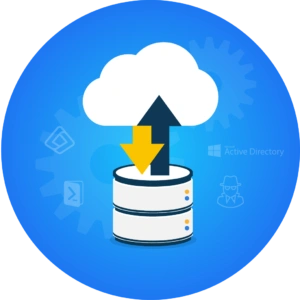Service Automation – Where to Start?
If you're part of a service or help desk team, your goal is to provide optimal support to your organisation. You're tasked with handling a high volume of tickets and responding to a variety of employee queries. The quicker these issues are resolved, the sooner employees can return to peak productivity. Automating tasks can be a game-changer, offering significant assistance. HelloID Service Automation is designed to facilitate this. This article will introduce you to this module, explore its capabilities, and highlight its benefits.
What is HelloID Service Automation
HelloID Service Automation is a module of the HelloID Identity & Access Management (IAM) solution. The module enables you to automate a wide range of manual activities. This brings considerable advantages, such as saving time, boosting employee productivity, and improving overall job satisfaction.

The range of tasks you can automate with HelloID Service Automation is incredibly diverse. Examples include processing requests for additional rights or resetting passwords. The module also enables you to standardise various tasks, such as linking data access rights to specific roles. The Service Automation module's flexible interface allows you to standardise numerous tasks efficiently.
The ten most common tickets
HelloID Service Automation can save you considerable time, which is beneficial as it allows you to better support the organisation and serve users more quickly. Are you ready to get started with HelloID Service Automation? Then, obviously, you'll want to maximise the benefits this module can offer.

Given the module's extensive flexibility, it's prudent to identify where it can be most beneficial. We recommend pinpointing the top ten most frequent tickets received by your service or help desk. These might include tasks like resetting passwords, managing requests for shared mailboxes, updating email addresses, or handling requests for additional rights and applications.
Self-service products vs. delegated forms
Did you identify the ten most common tickets? Now you can start standardising and automating these processes. Within Service Automation, you can use two components for this purpose: self-service products and Delegated Forms. Each option offers different possibilities and benefits, assisting you in standardising and automating various tasks.
Self-service products are primarily aimed at managing additional rights, such as access to a specific mailbox, project folder, or application. Through self-service products, users can request access themselves, have it approved, and then relinquish it. A key feature of self-service products within HelloID is that they have a status, allowing requested products to be returned or revoked after use. Another distinctive feature is the use of an approval workflow, where HelloID submits requests for approval to the relevant manager or product owner.

Delegated Forms are ideal for requests involving changes to accounts or account attributes, such as password updates or account modifications. They are also useful for creating new mailboxes and folders. Typically, tasks automated with Delegated Forms require more input from the requester compared to those processed through self-service products.
Using Delegated Forms, IT and HR professionals can initiate identity management tasks without requiring elevated permissions. This ensures that users do not hold unnecessary rights, which is crucial, as excessive rights could be exploited by malicious actors. Consequently, Delegated Forms significantly enhance your organisation’s digital security.
For more detailed information on the differences between self-service products and Delegated Forms, please visit this page.
Serving users more quickly
The advantages of HelloID Service Automation are extensive. For instance, this module allows you to automate a significant portion of your operational tasks. This reduces the time you spend on them, allowing you to serve the organisation more quickly and provide better support to users. The efficiency enables you to deliver services more rapidly and enhances user support. This enables them to get started sooner with, for example, a specific application or folder they need, boosting their productivity.
Simultaneously, it enhances the quality of your services, particularly by reducing the likelihood of errors. The standardised workflow enabled by HelloID Service Automation also enhances your logging capabilities. Should an issue arise unexpectedly or if you need to track when and why a specific change occurred, the detailed logs provide invaluable insights.

It's also beneficial to be able to delegate tasks to non or semi-skilled helpdesk staff and key users within your organisation. These key users are approachable colleagues on the floor who can assist their peers with some tasks using Delegated forms, lightening the load on the service or helpdesk.
Service Automation is particularly useful in situations where Role-Based Access Control (RBAC) is challenging, such as when organisations work with many freelancers or temporary staff, or when roles are not clearly defined. The module offers an automated and streamlined alternative, avoiding the need for constant coordination between the employee, service department, and manager, and making the organisation more self-directing.
On-premises and cloud sync
HelloID Service Automation relies significantly on Active Directory (AD) and Microsoft's Entra ID for automating tasks. If you make changes in AD or Entra ID, there's no need to continually adjust the configuration of the Service Automation module. Through synchronisation, all changes in AD and Entra ID are immediately adopted in HelloID Service Automation. For example, if users create a new shared mailbox via a Delegated form, you can also offer this mailbox directly as a self-service product, continuously elevating the organisation's self-sufficiency.
The HelloID Service Automation Agent is responsible for actions related to the HelloID Service Automation module. This agent runs on-premises and focuses on managing on-premises tasks, closely working with AD and enabling the creation of new SQL tables and NTFS folders, among other things.

Additionally, the HelloID Cloud Agent is also available. As more organisations operate entirely in the cloud but still wish to perform PowerShell actions for specific applications, the HelloID Cloud Agent enables the execution of custom PowerShell actions in your cloud environment. This includes performing PowerShell actions through Delegated forms or consulting PowerShell data sources. The HelloID Cloud Agent is primarily focused on making API calls to cloud web services
Depending on your environment's configuration, both the HelloID Service Automation Agent and the HelloID Cloud Agent can be utilised, which is particularly beneficial in hybrid setups.
Getting started
Do you want to get started with HelloID Service Automation? You can find more information here. If you have questions or would like to discuss further with our experts, please contact us.

Written by:
KaHo Man
KaHo, met 18 jaar ervaring in consultancy, is implementatie consultant in Identity & Access Management (IAM) bij Tools4ever. Met een solide basis in Hogere Informatica, is hij uitgegroeid tot een gerespecteerde mentor en trainer, die zijn kennis deelt met collega's en partners. KaHo's expertise strekt zich ook uit tot het geven van HelloID sales demo’s en technische intakes, uitvoeren van health checks, en het overzien van project reviews.
